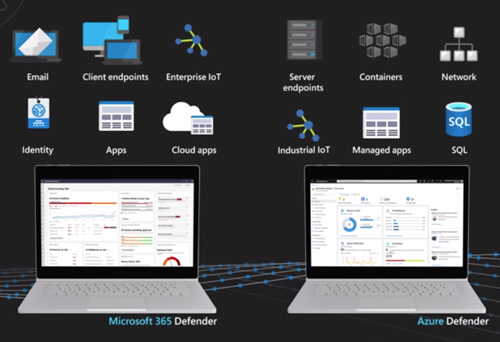News
Microsoft's Enterprise Security Lineup Gets a 'Defender'-Centric Rebrand
- By Kurt Mackie
- September 28, 2020
Microsoft renamed many of its enterprise security solutions at Ignite last week to include the phrase "Microsoft Defender."
The rebrand is complicated by the fact that Microsoft Defender is already the name of the anti-malware software that comes with Windows 10 client systems. However, what was announced last week pertains to Microsoft's enterprise security products used to secure desktops and apps in organizations. Those products offer capabilities beyond providing simple anti-malware protection. They get used for things like tracking attack campaigns and post-breach analyses.
Here are those new enterprise security product name changes, per an announcement by Rob Lefferts, corporate vice president for Microsoft 365 security:
- Microsoft 365 Defender (previously Microsoft Threat Protection).
- Microsoft Defender for Endpoint (previously Microsoft Defender Advanced Threat Protection).
- Microsoft Defender for Office 365 (previously Office 365 Advanced Threat Protection).
- Microsoft Defender for Identity (previously Azure Advanced Threat Protection).
It's maybe helpful to note that Microsoft 365 Defender (formerly "Microsoft Threat Protection") has been Microsoft's most inclusive top-of-the-line enterprise security product for securing on-premises infrastructures. Licensees get access to the following components, per this Microsoft document description:
- Microsoft Defender for Endpoint (formerly "Microsoft Defender Advanced Threat Protection"), which is used to protect endpoints and enable post-breach inspections.
- Microsoft Defender for Office 365 (formerly "Office 365 Advanced Threat Protection"), which is used to protect e-mail and collaboration applications from malicious attachments and links.
- Microsoft Defender for Identity (formerly "Azure Advanced Threat Protection"), which is used to identify threats due to compromised identities or malicious insiders.
- Microsoft Cloud App Security, used to add protections to software-as-a-service applications.
Microsoft 365 Defender vs. Azure Defender
If that weren't enough, Microsoft also has a Microsoft Defender product branch called "Azure Defender." Azure Defender is used by organizations tapping Microsoft's cloud services, or using a combination of on-premises servers with Microsoft's services (known as "hybrid").
Here's how Microsoft's announcement characterized the product distinctions between Microsoft 365 Defender and Azure Defender:
Microsoft Defender is delivered in two tailored experiences, Microsoft 365 Defender for end-user environments and Azure Defender for cloud and hybrid infrastructure.
Organizations can use Microsoft 365 Defender to protect things like e-mail, client endpoints, identity and apps. Organizations can use Azure Defender to add protections for server endpoints, containers, networks, managed apps and SQL Server.
The following Microsoft illustration showed those distinctions:
 [Click on image for larger view.] Protections afforded by Microsoft 365 Defender vs. Azure Defender. (Source: Microsoft Mechanics video)
[Click on image for larger view.] Protections afforded by Microsoft 365 Defender vs. Azure Defender. (Source: Microsoft Mechanics video)
Microsoft Defender as 'Holistic XDR'
Microsoft Defender for enterprise security was described as "holistic XDR" by Lefferts in a Microsoft Mechanics video available at this Microsoft security page.
Lefferts defined XDR, or extended detection and response, as "a new approach defined by industry analysts" for delivering "intelligent, automated, and integrated security across domains to help defenders connect seemingly disparate alerts and get ahead of attackers." He said that Microsoft is "unifying all XDR technologies under the Microsoft Defender brand."
XDR goes beyond typical endpoint detection and response solutions, according to this definition by Cisco.
In the announcement, Lefferts promoted combining Microsoft's on-premises and cloud enterprise security solutions. He stated that "together, Microsoft 365 Defender and Azure Defender give you an end-to-end XDR solution for threat detection and response, across your Microsoft estate, the cloud, on prem and in other clouds."
He further claimed that organizations can get security protections for other cloud services besides Microsoft Azure by using Azure Sentinel, Microsoft's cloud-based security information and event management (SIEM) solution.
Azure Security Center Multicloud Support
More detail on these enterprise security product shifts were described in an announcement by Vasu Jakkal, corporate vice president of security, compliance and identity at Microsoft. Microsoft is offering "a unique approach" by offering "both cloud-native SIEM and XDR tools from a single vendor," she explained.
Microsoft is also adding multicloud security management support to Azure Security Center. "Now you can see all your Azure, AWS, and GCP security posture in a unified experience within Azure Security Center," Jakkal added, pointing to this announcement.
A public preview of "integration between Microsoft Cloud App Security and Microsoft Information Protection," is now available. It "extends Microsoft's data loss prevention (DLP) policy enforcement framework to third-party cloud apps -- such as Dropbox, Box, Google Drive, Webex, and more -- for a consistent and seamless compliance experience," Jakkal explained.
In addition, Microsoft announced the general availability of its Compliance Manager solution. It can help with compliance issues, such as when there are "complex regulatory requirements" to meet. It produces a compliance score toward that end, Jakkal explained.
Microsoft's announcements during Ignite also included lots of details on specific new capabilities that were added to these enterprise security products.